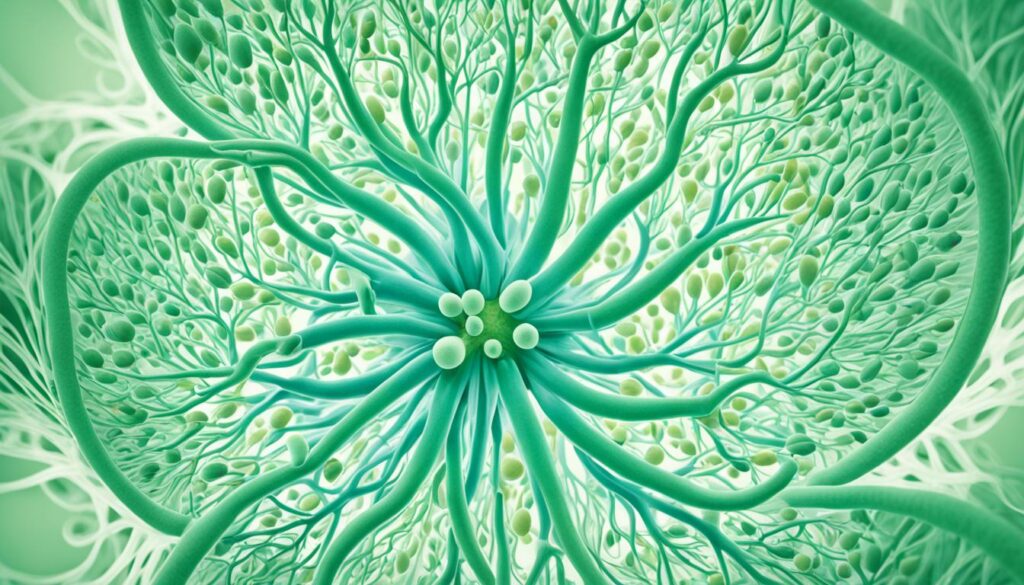Welcome to our article about bile duct autoimmune disease, also known as primary biliary cholangitis. In this section, we will provide you with an overview of this condition, its signs and symptoms, available treatments, and lifestyle adaptations that can help manage it. If you or someone you know is affected by primary biliary cholangitis, this information will be valuable in understanding the disease and its impact on your health.
Table of Contents
TogglePrimary biliary cholangitis is characterized by inflammation and damage to the bile ducts in the liver. It primarily affects women and is considered an autoimmune disease, where the body’s immune system mistakenly attacks healthy cells and tissue. Although the exact cause is unknown, genetic and environmental factors are believed to contribute to its development.
Signs and symptoms of primary biliary cholangitis may initially be subtle or absent. However, as the disease progresses, you may experience fatigue, itchy skin, jaundice, upper abdominal pain, swelling, joint pain, and more. It is important to recognize these symptoms and consult with your healthcare provider for a proper diagnosis.
While there is currently no cure for primary biliary cholangitis, medical treatments such as ursodeoxycholic acid (UDCA) can help slow the progression of liver damage. Additionally, making lifestyle adaptations such as following a healthy diet, engaging in regular exercise, and avoiding alcohol can play an important role in managing the disease.
Throughout this article, we will delve deeper into the various aspects of bile duct autoimmune disease, providing you with valuable insights and strategies to cope with the condition effectively. Stay tuned for more information on the signs, treatments, lifestyle adaptations, and the latest research in primary biliary cholangitis.
Bile Duct Damage and Liver Failure
The bile ducts play a crucial role in carrying bile from the liver to the small intestine for digestion. When these ducts become damaged, bile can back up into the liver, causing liver cell damage. In the case of primary biliary cholangitis, the bile ducts are inflamed and slowly destroyed, leading to ongoing inflammation in the liver and potential permanent scarring known as cirrhosis. As the liver cells are damaged and replaced with scar tissue, the liver’s ability to function properly can be compromised, potentially resulting in liver failure.

Primary biliary cholangitis is a condition where the body’s immune system mistakenly attacks the bile ducts in the liver. Over time, this inflammation and damage can lead to cirrhosis, a condition in which the liver becomes scarred and unable to function properly. When the liver fails to perform its necessary functions, it can have a significant impact on overall health and well-being.
When bile ducts are damaged, the flow of bile is disrupted, leading to several complications. Bile contains waste products, cholesterol, and bilirubin, which are essential for digestion and waste removal. If bile cannot flow properly, it can build up in the liver and cause liver cell damage. As liver cells are continually damaged, scar tissue forms, leading to cirrhosis.
The Consequences of Cirrhosis
Cirrhosis is a severe complication of bile duct damage and can result in liver failure. The liver is responsible for many vital functions, such as filtering toxins from the blood, producing important proteins, and aiding in digestion. When cirrhosis occurs, these functions are impaired, leading to a range of symptoms and potential complications.
The consequences of liver failure include:
- Fluid retention and swelling in the legs and abdomen
- Jaundice (yellowing of the skin and eyes)
- Easy bruising and bleeding
- Weakness and fatigue
- Confusion and cognitive difficulties
- Increased risk of infections
- Risk of liver cancer
It is crucial to manage bile duct damage and prevent further liver cell damage to avoid the progression to liver failure. Early diagnosis and appropriate treatment can help slow down the damage, preserve liver function, and improve overall quality of life.
Symptoms of Bile Duct Autoimmune Disease
In the early stages of primary biliary cholangitis, more than half of individuals may not experience any noticeable symptoms. However, as the disease progresses, symptoms can develop and worsen over time. It is important to be aware of these signs and seek medical attention if they occur. Here are some common symptoms associated with primary biliary cholangitis:
- Fatigue: Feeling tired and lacking energy
- Itchy skin: Persistent itchiness of the skin
- Jaundice: Yellowing of the skin and eyes
- Dry eyes and mouth: Lack of moisture in the eyes and mouth
- Upper abdominal pain: Discomfort or pain in the upper abdomen
- Swollen spleen: Enlargement of the spleen
- Bone and joint pain: Aching or soreness in the bones and joints
- Swollen feet and ankles: Edema in the lower extremities
- Fluid buildup in the abdomen (ascites): Accumulation of fluid in the abdominal cavity
- Fatty deposits on the skin: Small yellowish or pale bumps on the skin
- Darkening of the skin: Hyperpigmentation or dark patches on the skin
- Weak and brittle bones: Increased risk of fractures
- High cholesterol: Elevated levels of cholesterol in the blood
- Diarrhea: Frequent loose bowel movements
- Underactive thyroid: Reduced thyroid function
- Weight loss: Unintentional loss of body weight
If you experience any of these symptoms, it is important to consult your healthcare provider for an accurate diagnosis and appropriate management.
Causes and Risk Factors
Primary biliary cholangitis is believed to be an autoimmune disease where the body’s immune system mistakenly targets the bile ducts in the liver. While the exact cause of this condition is unknown, a combination of genetic and environmental factors is thought to play a role in triggering the disease.
Genetic factors: Some individuals may have a genetic predisposition to developing primary biliary cholangitis. It is more common in individuals of northern European descent.
Environmental factors: Certain environmental triggers may contribute to the development of primary biliary cholangitis. These factors can include infections, long-term cigarette smoking, and exposure to toxic chemicals.
Sex: Women are more commonly affected by primary biliary cholangitis than men. The reasons for this gender disparity are not fully understood.
Age: The disease typically affects individuals between the ages of 30 and 60 years old, although it can occur at any age.
Family history: Having a family history of primary biliary cholangitis increases the risk of developing the condition.
Identifying these causes and risk factors can help healthcare professionals better understand and manage primary biliary cholangitis.
Complications of Bile Duct Autoimmune Disease
As primary biliary cholangitis progresses, it can lead to several complications that affect various parts of the body. These complications arise due to ongoing liver damage and inflammation caused by the autoimmune disease. The most common complications associated with primary biliary cholangitis include:
Liver Scarring (Cirrhosis)
In advanced stages of primary biliary cholangitis, liver scarring, also known as cirrhosis, can occur. This scarring replaces healthy liver tissue and disrupts liver function, leading to further complications.
Portal Hypertension
Primary biliary cholangitis can result in increased pressure within the portal vein, a major blood vessel that carries blood from the digestive organs to the liver. This condition, known as portal hypertension, can lead to complications such as enlarged veins in the stomach and esophagus called varices.
Enlarged Spleen
As primary biliary cholangitis progresses, the spleen may become enlarged due to the increased pressure in the portal vein. An enlarged spleen can cause discomfort and may lead to complications such as anemia.
Gallstones and Bile Duct Stones
Individuals with primary biliary cholangitis are at an increased risk of developing gallstones and stones within the bile ducts. These stones can cause blockages and further impair liver function.
Liver Cancer
Long-standing inflammation and liver damage caused by primary biliary cholangitis can increase the risk of developing liver cancer or hepatocellular carcinoma.
Weak and Brittle Bones (Osteoporosis)
Primary biliary cholangitis can lead to weak and brittle bones, a condition known as osteoporosis. The liver plays a crucial role in vitamin D and calcium metabolism, and when liver function is compromised, it can result in reduced bone density and an increased risk of fractures.
Vitamin Deficiencies
Damage to the liver and impaired bile flow in primary biliary cholangitis can affect the absorption of essential vitamins, leading to deficiencies. Common vitamin deficiencies associated with this condition include vitamins A, D, E, and K.
High Cholesterol
Primary biliary cholangitis may cause alterations in lipid metabolism, resulting in high cholesterol levels. Elevated cholesterol levels can contribute to the development of heart disease and further complications.
Decreased Mental Function (Hepatic Encephalopathy)
In advanced stages of primary biliary cholangitis, hepatic encephalopathy, a condition characterized by impaired brain function, may occur. This condition arises due to the accumulation of toxins in the blood, which the liver is unable to effectively eliminate.
Associated Diseases
Individuals with primary biliary cholangitis may have an increased risk of developing other autoimmune diseases, such as thyroid disorders, skin disorders like vitiligo, and joint conditions like rheumatoid arthritis.
It is essential for individuals with primary biliary cholangitis to work closely with their healthcare team to manage and address these complications as part of their comprehensive treatment plan.

Diagnosis of Bile Duct Autoimmune Disease
To accurately diagnose primary biliary cholangitis, your healthcare provider will employ a combination of diagnostic tools. These tests are designed to assess your liver function and detect specific antibodies associated with the disease. The main methods used in the diagnosis of primary biliary cholangitis include:
- Blood tests: These tests evaluate the levels of liver enzymes, bilirubin, and specific autoantibodies in your blood. Abnormal levels can indicate liver damage and the presence of primary biliary cholangitis.
- Imaging studies: Your healthcare provider may order imaging tests, such as ultrasounds or magnetic resonance imaging (MRI), to visualize your liver and bile ducts. These images can help identify any structural abnormalities or blockages.
- Liver biopsy: In some cases, a liver biopsy may be necessary to confirm the diagnosis of primary biliary cholangitis. During this procedure, a small sample of liver tissue is obtained and examined under a microscope for signs of inflammation, damage, and scarring.
By analyzing the results of these tests, your healthcare provider can accurately diagnose primary biliary cholangitis and assess the extent of liver damage. It’s important to remember that early detection and diagnosis of the condition are crucial for timely intervention and management.
Treatment of Bile Duct Autoimmune Disease
While there is no cure for primary biliary cholangitis, there are several treatment options available to help manage the condition, slow the progression of liver damage, and alleviate symptoms. Treatment approaches may include medications and lifestyle adaptations.
Medications
Medications play a crucial role in the treatment of primary biliary cholangitis. One commonly prescribed medication is ursodeoxycholic acid (UDCA). UDCA helps improve liver function and reduce inflammation in the bile ducts. It is effective in slowing the progression of the disease and can help manage symptoms such as fatigue and itching.
Other medications may be prescribed to manage specific symptoms or complications associated with primary biliary cholangitis. For example, medications that promote bile flow or reduce itching may be prescribed as needed. Additionally, if a person develops complications like osteoporosis or vitamin deficiencies, their healthcare provider may recommend appropriate medications to address these conditions.
Lifestyle Adaptations
In addition to medications, making certain lifestyle adaptations can significantly improve your quality of life and support liver health. Here are some key lifestyle changes you can make:
- Follow a healthy and well-balanced diet: A diet rich in fruits, vegetables, whole grains, lean proteins, and healthy fats can help support liver health. It’s important to limit the intake of processed foods, saturated fats, and sugary beverages.
- Engage in regular physical activity: Regular exercise can help improve liver function, reduce inflammation, and manage weight. Aim for at least 150 minutes of moderate-intensity aerobic activity or 75 minutes of vigorous-intensity activity per week.
- Avoid alcohol: Alcohol can worsen liver damage and should be completely avoided if you have primary biliary cholangitis. It’s important to discuss alcohol consumption with your healthcare provider and seek support if needed.
- Maintain a healthy weight: Excess weight can put additional strain on the liver. Achieving and maintaining a healthy weight through a combination of a balanced diet and regular exercise can help reduce liver inflammation and improve overall health.
- Quit smoking: Smoking has been linked to a faster progression of liver damage in individuals with primary biliary cholangitis. Quitting smoking is essential for reducing the risk of complications and improving liver health.
Remember to consult with your healthcare provider before making any significant changes to your medication regimen or lifestyle. They can provide personalized recommendations based on your specific needs and condition.

| Treatment Options | Description |
|---|---|
| Medications | Prescribed to improve liver function, reduce inflammation, and manage symptoms. |
| Lifestyle Adaptations | Incorporating a healthy diet, regular exercise, and avoiding alcohol to support liver health. |
Research and Outlook for Bile Duct Autoimmune Disease
Ongoing research is focused on improving the understanding and treatment options for primary biliary cholangitis. Clinical trials are exploring new medications and therapies to further slow disease progression and improve outcomes for individuals with this condition. It is important for individuals with primary biliary cholangitis to work closely with their healthcare team and stay informed about the latest advancements and research opportunities.
Research plays a critical role in advancing our knowledge of primary biliary cholangitis and identifying more effective treatment strategies. Scientists and medical professionals are dedicated to uncovering new insights and developing innovative approaches to managing this complex disease. Through ongoing studies, promising treatment advancements are being discovered, providing hope for improved outcomes and a brighter future for individuals living with primary biliary cholangitis.
These ongoing studies aim to:
- Enhance understanding of the underlying causes of primary biliary cholangitis
- Identify potential biomarkers for early diagnosis and disease monitoring
- Explore novel therapeutic targets for more tailored treatment options
- Assess the efficacy and safety of emerging medications and therapies
- Investigate the impact of lifestyle modifications on disease progression
Stay Informed and Engaged
As a patient with primary biliary cholangitis, it is crucial to stay informed about the latest research advancements and opportunities for participation in clinical trials. By actively engaging with your healthcare team and participating in research studies, you can contribute to the advancement of medical knowledge and potentially have access to cutting-edge treatments and therapies.
Advancements in our understanding of primary biliary cholangitis continue to bring hope for improved quality of life and better outcomes. Stay proactive in your healthcare journey, attend support groups, and seek out reputable sources of information to stay up-to-date with the latest developments in the field. Remember, you are not alone in this fight, and together we can strive for better treatment options, improved management strategies, and ultimately, a brighter future for those affected by primary biliary cholangitis.

Image: Ongoing research is crucial for advancing the understanding and treatment of primary biliary cholangitis.
Conclusion
Bile duct autoimmune disease, also known as primary biliary cholangitis, is a chronic condition that primarily affects women. It is an autoimmune disease where your body’s immune system mistakenly attacks the bile ducts in your liver. Although there is no cure for primary biliary cholangitis, there are medical treatments available that can help manage the disease and slow down the progression of liver damage.
It is crucial for you to work closely with your healthcare team to follow the recommended treatment plans and make the necessary lifestyle changes to support your liver health. This may include taking prescribed medications, such as ursodeoxycholic acid (UDCA), and adopting a healthy diet and regular exercise routine.
Research and advancements in treatment options offer hope for improved outcomes in the future. Ongoing clinical trials and studies are focused on developing new medications and therapies to further enhance disease management and quality of life for individuals with primary biliary cholangitis.
FAQ
What is bile duct autoimmune disease?
Bile duct autoimmune disease, also known as primary biliary cholangitis, is a chronic condition characterized by inflammation and damage to the bile ducts in the liver.
Who does primary biliary cholangitis primarily affect?
Primary biliary cholangitis primarily affects women.
What are the symptoms of primary biliary cholangitis?
Symptoms of primary biliary cholangitis can include fatigue, itchy skin, jaundice, upper abdominal pain, joint pain, and more.
What causes primary biliary cholangitis?
The exact cause of primary biliary cholangitis is unknown, but it is believed to be a combination of genetic and environmental factors.
What are the complications of primary biliary cholangitis?
Complications of primary biliary cholangitis can include liver scarring (cirrhosis), portal hypertension, varices, spleen enlargement, gallstones, liver cancer, weak bones, vitamin deficiencies, high cholesterol, and more.
How is primary biliary cholangitis diagnosed?
Diagnosis of primary biliary cholangitis typically involves a combination of blood tests and imaging studies, such as liver enzyme tests and a liver biopsy.
How is primary biliary cholangitis treated?
While there is no cure for primary biliary cholangitis, medical treatments such as ursodeoxycholic acid (UDCA) can help manage the disease and improve liver function. Lifestyle adaptations such as a healthy diet and regular exercise can also support liver health.
What is the outlook for primary biliary cholangitis?
Ongoing research is focused on improving treatment options for primary biliary cholangitis, offering hope for improved outcomes in the future.
Source Links


